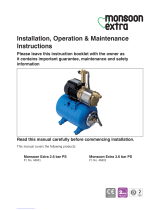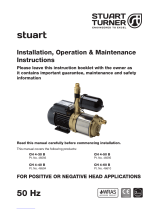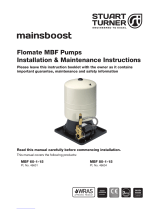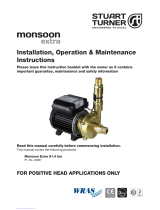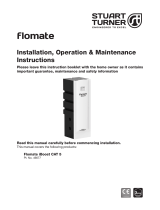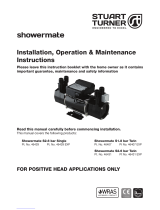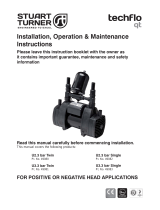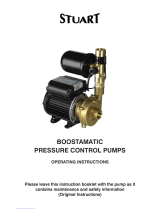
- 19 –
Cont ...
8 TROUBLE SHOOTING GUIDE
Symptoms Probable Cause Recommended Action
Pump will not start. Electrical supply. Check power supply.
Check fuse (see fuse section).
Check circuit breaker is set.
Check wiring connections.
Pump Jammed. If motor ‘Buzzes’ switch off power and contact Stuart
Turner.
Damaged pressure switch. Turn off power.
Release system water pressure.
Turn on power, pump should start. If NOT contact Stuart
Turner.
Recommended static inlet/
outlet heads exceeded.
Re-position pump (see pump location section).
Internal motor thermotrip
activated.
Wait for thermotrip to auto-reset and check that duty
point and run time is within specification (see technical
specification).
Reduced/intermittent flow. Incorrect or no anti-aeration
flange fitted
Check that the installation complies with installation
instructions.
Incorrect pipe sizes. Check for correct pipe sizing, see Page 8 – Section 2.19.
Blocked inlet filters. Clean inlet filters (see maintenance section).
Hot water temperature set
too high.
Reduce cylinder stat setting to 60
o
C max.
Blocked shower head spray
plate
Clean in accordance with manufacturers instructions.
No hot water. Air locked water feed. Vent hot water pump of air.
Check cold feed to hot water cylinder.
Check water level in cold water tank and that all stopcocks
and isolating valves are open.
Heat source not operating. Check boiler is switched ‘on’.
Check cylinder thermostat.
Check immersion heater.
Check cylinder contains hot water.
All hot water has been used. Check tank volume is adequate.
Faulty thermostatic mixer
valve.
Consult makers instructions.
Pump runs on with outlets
closed.
Leak in system. Check tap washers, w/c valve washers, pipe joints.
Damaged reed switch, P.C.B
or pressure switch.
If pump continues to run, this indicates a closed circuit in
either the flow switch reed, pressure switch or P.C.B. in the
terminal box. Contact Stuart Turner.
Jammed flow switch. Remove outlet hoses and check that flow switch sits in
lowest position. Check float for free movement.
or
Pump cycles (hunts) on/off
frequently.
Low pressure in pressure
vessel.
Check pressure in pressure vessel (see maintenance
section).
Debris under non-return valve
sealing face.
Run at full flow to try and flush away debris or remove,
clean or replace non-return valve.
Flexible hose leaks Not fitted correctly. Check that the hose is pushed firmly onto the pump inlet/
outlet connections and pipework.
Damaged ‘O’-rings. Check copper pipe ends are cleanly cut and deburred.




















